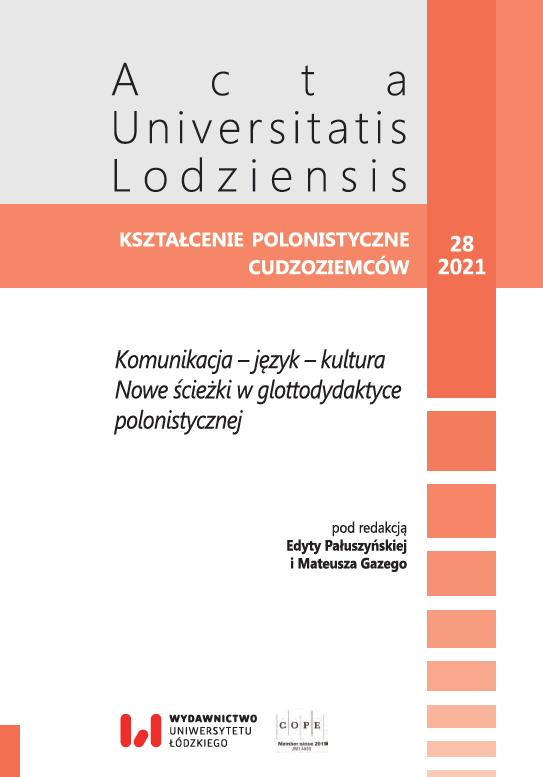The neurobiological and cultural aspects of the ways of acquiring and processing information, as exemplified by chinese students learning polish as a foreign language
DOI:
https://doi.org/10.18778/0860-6587.28.10Keywords:
Polish as a foreign language, Chinese, cultural aspects, learning patterns, righ-brained strategiesAbstract
The subject of the article is the influence of neurobiological and cultural factors on the ways of acquiring and processing information, which in turn determine the choice of learning methods. The paper discusses the issue of hemispherical preferences in the educational context. The starting point of the research is the thesis that individuals using Mandarin as their native tongue and raised in the Chinese culture prefer those ways of acquiring knowledge which activate the right cerebral hemisphere. The research presents the results of observations and interviews held with students from China who have been learning Polish as a foreign language, about the learning methods and techniques that they use. The research conclusions have been interpreted on the basis of the cultural factors (native tongue and social practices) that are particularly conducive to choosing right-hemisphere strategies in the learning process.
References
Afek J., Gut A., 2017, O chińskim modelu wczesnej edukacji dziecięcej w kontekście międzykulturowych badań psychologicznych, „Roczniki Humanistyczne”, nr 65(9), s. 5–28. DOI 10.18290/rh.2017.65.9-1
Google Scholar
DOI: https://doi.org/10.18290/rh.2017.65.9-1
Berko Gleason J., Bernstein Ratner N., 2005, Psycholingwistyka, Gdańsk.
Google Scholar
Boski P., 2010, Kulturowe ramy zachowań społecznych. Podręcznik psychologii międzykulturowej, Warszawa.
Google Scholar
Budohoska W., Grabowska A., 1994, Dwie półkule – jeden mózg, Warszawa.
Google Scholar
Cao F., Vu M., Chan D.H.L., Lawrence J.M., Harris L.N., Guan Q., Xu Y., Perfetti C.A., 2013, Writing affects the brain network of reading in Chinese: A functional magnetic resonance imaging study. „Human Brain Mapping”, 34 (7), s. 1670–1684. DOI: 10.1002/hbm.22017
Google Scholar
DOI: https://doi.org/10.1002/hbm.22017
Cieszyńska-Rożek J., 2013, Metoda krakowska wobec zaburzeń rozwoju dzieci. Z perspektywy fenomenologii, neurobiologii i językoznawstwa, Kraków.
Google Scholar
Durham W., 1991, Coevolution – genes, culture, and human diversity, Stanford.
Google Scholar
DOI: https://doi.org/10.1515/9781503621534
Gazzaniga M.S., 2011, Istota człowieczeństwa. Co sprawia, że jesteśmy wyjątkowi, Sopot.
Google Scholar
Grabowska A., 2012, Lateralizacja funkcji psychicznych w mózgu człowieka, w: T. Górska, A. Grabowska, J. Zagrodzka (red.), Mózg a zachowanie, Warszawa, s. 443–488.
Google Scholar
Hall E., 1976/2001, Poza kulturą, Warszawa.
Google Scholar
Jacoby M., 2016, Chiny bez makijażu, Warszawa.
Google Scholar
Jianquiao G., Gang P., Bingjiang L., Yi W., Yan Z., Zhendong N. i in., 2015, Cross-language differences in the brain network subserving intelligible speech, Proceedings National Academy of Sciences of the USA, t. 112:10, s. 2972–2977. DOI: 10.1073/pnas.1416000112
Google Scholar
DOI: https://doi.org/10.1073/pnas.1416000112
Kohn L., 2012, Taoizm. Wprowadzenie, Kraków.
Google Scholar
Markus H., Kitayama S., 1993, Kultura i ja. Implikacje dla celów poznawczych, emocji i motywacji, „Nowiny Psychologiczne, nr 3, s. 5–70.
Google Scholar
Matsumoto D., Juang l., 2007, Psychologia międzykulturowa, Gdańsk.
Google Scholar
Nisbett R.E., 2010, Inteligencja. Sposoby oddziaływania na IQ, Sopot.
Google Scholar
Nisbett R.E., 2015, Geografia myślenia. Dlaczego ludzie Wschodu i Zachodu myślą inaczej?, Sopot.
Google Scholar
Nisbett R.E., Peng K., Choi I., Norenzayan A., 2001, Culture and systems of thought: Holistic versus analytic cognition, ,,Psychological Review”, nr 108, s. 291–310. DOI: 10.1037/0033-295x.108.2.291
Google Scholar
DOI: https://doi.org/10.1037/0033-295X.108.2.291
Norenzayan A., Smith E., Kim B.J, Nisbett R.E., 2002, Cultural preferences for formal versus intuitive reasoning, „Cognitive Science”, nr 26, s. 653–684. DOI 10.1016/S0364-0213(02)00082-4
Google Scholar
DOI: https://doi.org/10.1207/s15516709cog2605_4
Panasiuk J., 2017, Neurobiologiczne podstawy mowy, w: S. Milewski, J. Kuczkowski, K. Kaczorowska-Bray (red.), Biomedyczne podstawy logopedii, Gdańsk, s. 359–409.
Google Scholar
Stanulewicz D., 2018, Język a kultura i środowisko, w: E. Czaplewska (red.), Logopedia międzykulturowa, Gdańsk, s. 26–39.
Google Scholar
Szeląg E., 2012, Mózgowe mechanizmy mowy, w: T. Górska, A. Grabowska, J. Zagrodzka (red.), Mózg a zachowanie, Warszawa, s. 489–524.
Google Scholar
Tomasello M., 2002, Kulturowe źródła ludzkiego poznawania, Warszawa.
Google Scholar
Downloads
Published
How to Cite
Issue
Section
License

This work is licensed under a Creative Commons Attribution-NonCommercial-NoDerivatives 4.0 International License.










